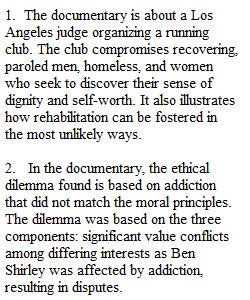


Q SPAD 284: Issues and Ethics in Sport Media Activity #4 – Skidrow Marathon Directions: Watch Skid Row Marathon. You can access it for free if you have Amazon Prime. If you do not have an account, it appears you can watch for free with ads on a couple of websites identified here: https://www.justwatch.com/us/movie/skid-row-marathon. Once you watch the documentary, fully answer each of the following questions using complete sentences. Please type your responses (in a different font color) directly on this document and upload it to Blackboard. 1) Give a brief review of the documentary (one paragraph of at least three sentences). 2) Identify an ethical dilemma present in the documentary. To receive credit, explain how it is an ethical dilemma by incorporating the three components of an ethical dilemma (hint: look at slide 11 from the very first PowerPoint in class). 3) Provide an example of how two of the six types of power were depicted in the documentary. **Identify and define the type of power before providing the example from the documentary. 4) Judge Craig Mitchell brought hope to the homeless through running. Using Cavanaugh’s Model of Decision Making, explain how Judge Mitchell may have decided to start the Skid Row Running Club. Make sure you explicitly answer each of the questions associated with utility, rights, and justice in Cavanaugh’s Model before addressing the question about starting the running club. 4) Judge Craig Mitchell brought hope to the homeless through running. Using Cavanaugh’s Model of Decision Making, explain how Judge Mitchell may have decided to start the Skid Row Running Club. Make sure you explicitly answer each of the questions associated with utility, rights, and justice in Cavanaugh’s Model before addressing the question about starting the running club.
View Related Questions